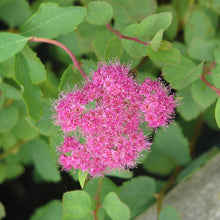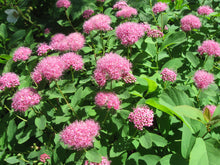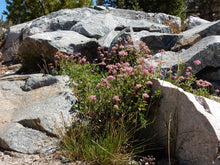Spiraea splendens (formerly/aka Spiraea densiflora)
This beauty goes by many common names; rosy spiraea, subalpine or mountain spiraea, and meadowsweet. It is a relatively small, deciduous, hardy shrub that broadcasts dense clusters of fuzzy pink flowers revered by bees and butterflies. Blooms are faintly sweet-smelling, reminiscent of cloves and, after a long-lasting floral show, become diminutive fruits in late summer. Like other spiraeas, its small light green leaves turn attractive hues of yellow, orange and even red with the onset of cold fall weather.
- Plant type/canopy layer: deciduous, perennial, small shrub
- Size at maturity: 1-3' high, 2-3' wide
- Light requirements: full sun, part sun/part shade
- Moisture requirements: moist soil, prefers well-drained
- Bloom time: June - September
- Growth rate/ease: fast growing, easy to grow
- Wildlife support: flowers attract and provide nectar to adult butterflies, bees and other insect pollinators; overall plant attracts and supports beneficial and pest eating insects and is a caterpillar host plant and larval food source for native moths and butterflies
- Native habitat/range: found growing on streambanks, moist meadows and open, rocky slopes, at mid-to-high elevations, on the west coast from British Columbia to central California, especially along inland mountain ranges. Portland Plant List - no.
- Special features & uses: flowering stems have traditionally been used as paint brushes; landscape uses include pollinator gardens, rock gardens, raingardens and hedgerows
Gardening with Alpine Spirea: It isn't difficult to find a great spot for this reliable, highly-ornamental shrub - especially since it's one of the few native shrubs that doesn’t become enormous! It will thrive in part to full sun areas with moist to seasonally wet soil, preferably with fast drainage. It’s particularly attractive in groupings, as a flowering addition to habitat hedgerows, or in a sunny raingarden.
Photo Credit 1: "Spiraea splendens" by peganum is licensed under CC BY-SA 2.0.
Photo Credit 2: "Rose Meadowsweet - Spiraea splendens" by Forest Service - Northern Region is marked with Public Domain Mark 1.0.
Photo Credit 3: "Spiraea splendens" by Matt Lavin is licensed under CC BY-SA 2.0.






